Intel Core Duo: AOpen i975Xa-YDG to the Rescue
by Gary Key on May 4, 2006 8:00 AM EST- Posted in
- Motherboards
Synthetic Graphics Performance
The 3DMark series of benchmarks developed and provided by Futuremark are among the most widely used tools for benchmark reporting and comparisons. Although the benchmarks are very useful for providing apple to apple comparisons across a broad array of GPU and CPU configurations they are not a substitute for actual application and gaming benchmarks. In this sense we consider the 3DMark benchmarks to be purely synthetic in nature but still valuable for providing consistent measurements of performance.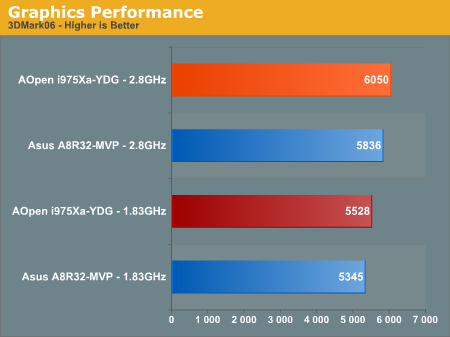
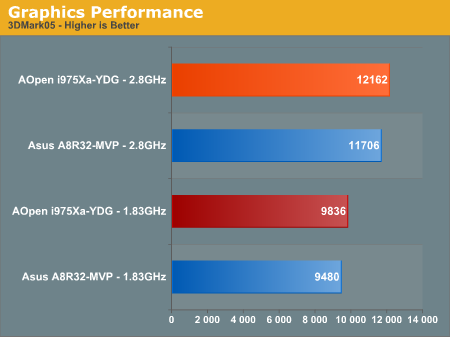
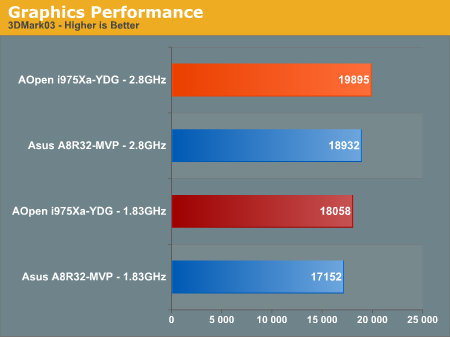
In our first tests, the combination of the Intel Core Duo and AOpen i975Xa-YDG makes for an impressive showing against the AMD Opteron 165/175 and Asus A8R32-MVP setup at both stock and overclocked settings. The Intel platform had no issues running the full 3DMark series when overclocked but our AMD platform struggled at first until we dialed in the right mix of voltages and memory settings.
General System Performance
The PCMark05 benchmark developed and provided by Futuremark was designed for determining overall system performance for the typical home computing user. This tool provides both system and component level benchmarking results utilizing subsets of real world applications or programs. This benchmark is useful for providing comparative results across a broad array of Graphics subsystems, CPU, Hard Disk, and Memory configurations along with multithreading results. In this sense we consider the PCMark benchmark to be both synthetic and real world in nature while providing consistency in our benchmark results.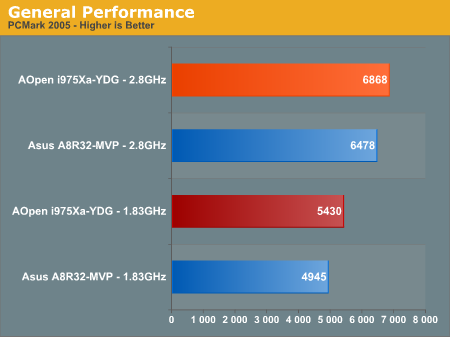
The margins are closer in the PCMark05 results but the Intel platform continues to show an advantage over the AMD platform at stock and overclocked settings. It is obvious from our test results that we can expect even greater results from the Conroe and Merom processor series.
Rendering Performance
We have added the Cinebench 9.5 and POV-RAY 3.6 benchmarks as they heavily stress the CPU subsystem while performing graphics modeling and rendering. We utilize the standard benchmark demos in each program along with the default settings. Cinebench 9.5 features two different benchmarks with one test utilizing a single core and the second test showcasing the power of multiple cores in rendering the benchmark image. We had planned on generating 3dsmax 7 benchmarks but our AMD platform would not complete the underwater benchmark. We are still investigating this issue.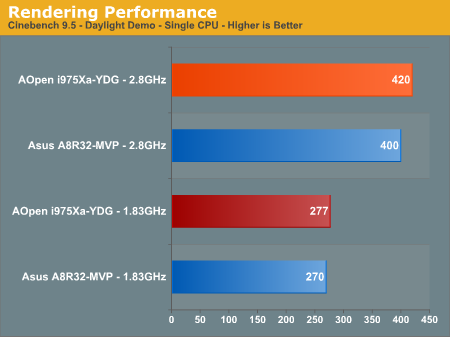
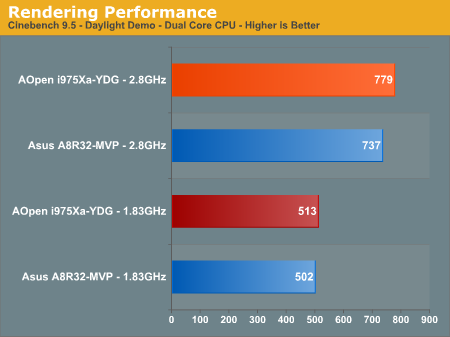
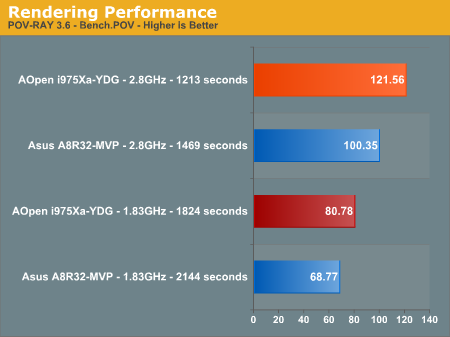
The Intel Core Duo desktop platform showed its strength in the extremely demanding POV-RAY benchmark, bettering the AMD platform by 18%. In our limited testing with the Asus N4L-VM featuring the 945GM mobile chipset our stock Intel Core Duo numbers were slightly better than the AMD platform in the Cinebench 9.5 benchmark and only about 6% greater in the POV-RAY benchmark indicating AOpen's choice of the i975x chipset certainly makes a difference in the performance ability of the Core Duo.










81 Comments
View All Comments
snorre - Thursday, May 4, 2006 - link
What in the world are you doing?Is AT's review's getting worse and worse???
This has to be one of the worst reviews ever... comparable to those found at Tom's...
Gary... what in the world were you on when you did this review???
ANANDTECH
in our next review, we'd like to show your how an AthlonFX60 compares to a 2.8Ghz Celeron
........."as you can see, the Celeron just cannot keep up with the AMD monster, looks like intel is really going to have to pick up the pace or AMD could rule the frickin' world with this new behemoth"
For real though, did Intel pay you off for this review???
I've been a loyal Anandtecher for quite some time, and if I keep seeing reviews of this caliber, I've no choice than to delete my bookmark.
kmmatney - Thursday, May 4, 2006 - link
I wouldn't mind if you deleted your bookmark. Your post was one of the dumbest things I've ever read.Gary Key - Thursday, May 4, 2006 - link
I am replying to your post. What are you doing?
It depends on how you look at it. I am usually positive so I think the three reviews posted on our website this week are probably some of the best you will read. However, I really did enjoy a mobile hard drive article at Tech Report this week.
How exactly is this one of the worst reviews ever? Really, I would like to know so I can address any shortcomings in future articles? My personal grade was a B+ to A-, the article really needed the 3dsmax 7 benchmark (still working on but our Opteron/Asus combo barfs on it during overclocking, trying a new load tonight), a Photoshop benchmark would have been nice, Oblivion benchmark is coming, a Sim or RTS benchmark would be great, and thermals will be posted once we come to a decision on what numbers to post.
After seeing the other reviews on this board I see very little real world application benchmarks for every option on the board, the lack of overclocking, and CrossFire is totally absent. Tell us what we can do better, we are listening. :)
I was on my Herman Miller Mirra for about 140 hours while completing this article. :)
That is a very good idea, actually the Celeron would win if we only tested power consumption, thermals, and pricing. I guess Intel wins this battle without much of a fight and I can complete this article in a few hours instead of weeks. ;-)
Actually, Intel declined our request for a Duo Core CPU for this article. I purchased it from NewEgg directly and will have to explain to the wife why I spent $327 to get insulted.
We hope you continue to be a loyal reader and while I disagree with your assessment of our article, I do respect your right to an opinion.
snorre - Friday, May 5, 2006 - link
Commenting on your no-good review of course.
As a review of AOpen i975Xa-YDG I guess it's all ok, but the comparison of Core Duo to Opteron is really hopeless IMHO. What were you thinking?! Just a brief look at your test setup made me really mad, the AMD box is totally inadequate set up to say the very least. If you're going to do a desktop processor comparison, then please do it properly with the best possible desktop processors, motherboards/chipsets, memory and graphics cards currently available. Just to get you started; Opteron 175, Asus A8R32-MVP, OCZ EB DDR PC-4000 Platnium Edition and ATI X1900 CrossFire are hardly the best setup the AMD platform can provide today.
And with regards to comparing overclocked processors; C'mon give us a break!
I'm starting to wonder if you set up the mysterious AMD box yourself when you published all those fishy Conroe benchmarks from IDF earler this year... *sigh*
That was a joke if you didn't get it. At first glance your review reminded me about Kristopher Kubicki's hopeless comparison of Intel Xeon Nocona 3.6GHz to AMD Athlon 64 3500+.
What's next? Anandtech's server shoot-out: Intel Woodcrest vs. AMD Sempron? That'd be really interesting....NOT!
Thank you, I do too. Still, I hope you shape on your benchmarking in the future. Anandtech should know better than to do benchmarketing like this, unless you loose your credibility as an independent review site IMHO. Be critical, provide us with facts and not marketing bullshit, please!
Gary Key - Friday, May 5, 2006 - link
Please tell us what possible platform changes could have been made in order to keep the comparison fair? This was a motherboard review, different than what we normally do with the facts as to our component choices were explained thoroughly in the article, and not a CPU comparison although it lended itself well to that point in the end. If I were doing a CPU comparison, it would have been FX60+ versus Conroe E6800, and lets just say you would have been even more upset with the results regardless of board, video, or memory choices. ;-)
In order-
1. What AMD processor would you have used for the stock clock settings? The T2400 in our review runs at 1.83GHz and is a dual core design, you must stay at this CPU speed for a fair comparison.
2. What AMD motherboard would have been your choice? It has to have CrossFire capability in order to match the specs on the AOpen board. There are only about eight choices and they all perform within a couple of percent of each other.
3. What 1GB x 2 DDR memory kit would you have chosen? Remember our memory choice for the Intel platform runs at 3-3-3-8 at stock and at 4-4-4-15 at the 11x255 setting. Our OCZ is in the top two choices of 1GB DDR sticks, in our testing it ran at 3-3-2-7 1T at stock and at 3-3-3-7 1T at the 11x255 settings, giving it an advantage over the DDR2 system. A CAS2 or CAS2.5 setting would have improved the AMD platform scores at the stock settings but remember, we are equalizing all items within the platform for testing and these settings must pass our benchmark tests.
4. What ATI card or otherwise would you have chosen for CrossFire testing? I am really interested in this one as the last time I checked the 7900GTXs did not have official SLI support in the Intel board. It is a toss up in most situations between the two cards anyway, what other cards currently on the market are better?
5. What AMD CPU would you have chosen for running at the 11x multiplier? Remember, it must be 11x and a dual core.
Why, we always show overclocked results in our motherboard comparisons. Are you just upset with results?
I never published any Conroe benchmarks or attended IDF this year.
I did get, my response was a joke also. Did you get it?
We are an independent review site. I was critical in the review about the board's shortcomings, took shots at NetBurst technology several times, and briefly touched on the Core Duo issues with 64-bit extensions even though this was not a CPU article. The results presented are facts, thoroughly reviewed, and retested over a dozen times. Our results are based on these facts, in fact we used numerous real world applications in this review and stayed away from presenting strictly synthetic benchmarks which obviously favored Intel. I cannot begin to understand why you believe this was marketing b.s. as we real world applications, equal platforms, default settings, and presented the results as fairly as possible. Intel was never involved, never provided review materials, as this review was about the AOpen i975Xa-YDG and its ability to work as advertised. It was a fair review, end of subject.
I was just as surprised as anyone else with the results. The numbers speak for themselves, if you do not like them there is nothing I can do about it. If these results upset you then I highly suggest you take some Prozac before this July. ;-)
In the end we will have to agree to disagree. However, if you still think we are spewing marketing propaganda then visit http://www.xtremesystems.com/index.php">XS- Your Source for Conroe/Yonah Benchmarks and see what users are doing with these chips. These same users are some of the most avid AMD enthusiasts on the planet. Thank you. :)
snorre - Friday, May 5, 2006 - link
Athlon 64 FX-60 downclocked to 1.8GHz, although I don't see why as I find comparing clock frequencies across microarchitectures totally irrelevant.
I don't see why it has to have CrossFire for? To really match the specs on the Asus board the AOpen board also has to have ATi CrossFire Xpress 3200 chipset and it don't. DFI Lanparty UT NF4 SLI-DR Expert would be my AMD motherboard of choice and I'd DFI Lanparty UT NF4 SLI-DR Expert and I'd have tested it with a single nVIDIA GeForce 7900GTX 512MB GDDR3 graphics card on both boards (no SLI).
I'd have used 2 x Crucial PC4000 BallistiX Tracer 1024MB running 2.5-2-2-5 1T @ 250MHz HTT. Using slower memory would give Core Duo's faster shared cache a unfair advantage in my opinion.
If you're so interested in testing CrossFire I'd do it on the nForce4 SLI board mentioned above, but I'm more interested seeing single card benchmarks like 7900GTX.
Athlon 64 FX-60 as you can set the multiplier to anything you like, but as I said I find this requirement strange because I find comparisons of clock frequencies across microarchitectures totally irrelevant.
I'm only upset with what I regard as a flawed test setup that in turn made the results totally uinteresting to me.
Good, I was a bit unsure there for a second ;-)
Good to hear it, and I hope it will stay that way in the future too. Sorry for being so harsh, on second thought it seems like I mistaked you for just another Kristopher Kubicki clone (he got a few bad reviews on his record FYI).
Gary Key - Friday, May 5, 2006 - link
How would an FX-60 make a difference? I can try it, but the differences in previous testing with an FX-60 down clocked to match an Opteron showed zero differences (same memory controller). If you are comparing CPU architectures then performance comparisons at like clock speeds is of great value to determine design advantages. AMD's greatest advantage with the Athlon64 series has been their performance per watt when compared to the Intel Pentium 4 series. A level that after several years Intel is just now equaling. In terms of product histories, this is an incredible feat for AMD.
It needed to be CrossFire capable as the AOpen board fully supports CrossFire, a feature on the board that was fully tested and compared to another CrossFire capable board. I have not seen any performance advantages of the DFI Lanparty UT NF4 over the Asus A8R32 at stock speeds, in fact the Asus board commands a 2%~3% performance advantage across the board in testing. This is no surprise as DFI forgoes stock level performance in order to ensure they have the highest performing boards when overclocking. As part of our test suite, we test all boards with the latest GPU options. I tested both boards with an EVGA 7900GTX and had the same results (percentage differences) in the benchmarks. Any thoughts that the NVIDIA card would make a difference is incorrect. In fact, on the HL2-LC scores the AMD platform went from a tie to a 4% disadvantage.
I ran the OCZ at 2.5-3-2-7 1T on a couple of benchmarks at the stock settings, had about a 1% positive effect at the stock settings, same for running some new Corsair memory on the AOpen board at 3-2-2-8, even trade. However, I did not run any benchmarks at the overclocked settings yet.
CrossFire does not work on the NF4 boards without a hack which causes a performance decrease of up to 8% in most cases so this option is not viable.
Flawed because the numbers did not go in AMD's favor? For an article that was uninteresting you certainly have made an incredible amount of statements about it. :)
We all will have bad reviews at one time or the other. :) Cheers......
snorre - Saturday, May 6, 2006 - link
For one thing, it's the best desktop processor AMD have to offer right now. Secondly, it's a far better overclocker since its memory controller works flawlessly with DDR500 memory at the exact same timings as DDR400 memory. Thirdly, it dosen't have any multiplier lock.
I really doubt that a board based on ATi CrossFire Xpress 3200 performs better on average than a board based on nVIDIA nForce4 SLI X16. DFI Lanparty UT NF4 SLI-DR Expert is currently regarded by many enthusiasts as the best nVIDIA nForce4 SLI X16 based board out there, but if you don't like it then I'd suggest Asus A8N32-SLI Deluxe instead.
With a proper nForce4 SLI X16 board, Athlon 64 FX-60 and Crucial PC4000 BallistiX Tracer 1024MB running 2.5-2-2-5 1T @ 250MHz HTT there should be a noticable difference. If not something must be seriously wrong with your test methodology.
I don't know the OCZ memory or the board you used, but if you only see 1% performance improvements going from 3-3-3-8 1T to 2.5-3-2-7 1T then something seriously must be wrong. I'd expect 3-5% performance increase on average depending on memory intensive benchmarks, e.g. RealStorm Global Illumination Benchmark 2006. However, I'd strongly suggest that you run the OCZ memory at DDR500 speeds with the best possible timings. If it can't handle it, then switch to Crucial PC4000 BallistiX Tracer 1024MB sticks instead.
No, because I still question your test setup. This one's for you:
The only genuinely objective benchmark is the one left on a person's trousers when they sit on a bench that has just been painted.
I'm not your average reader either, but hey your average reader dosen't bother commenting your articles either right? :)
Yeah, after all it's human to fail. Quite understandable as long as we learn from our failures, else we're condemned to repeat history. Fool us once shame on you, fool us twice shame on us.
Cheers! :)
Gary Key - Saturday, May 6, 2006 - link
Our Opterons have the same E6 memory controller as our FX60. The FX60 down clocked to 9x204 or 11x255 does not generate any different scores. It does not overclock any better than our Opterons on air or water. In fact our Opteron 170 overclocks to 2.90GHZ on air and 3.05GHz on a cheap water system. The FX60 does 2.82GHz on air and barely hits 3.0GHz on the cheap water system.
Some do, some do not, already have the Asus A8N32-SLI, sorry scores are not any better at our test settings. Please purchase the DFI CFX3200 and try it. :)
If you had read the review completely you would know what memory and board we used. ;-)
The majority of memory benchmarks show an advantage of up to 37% for the AMD platform we tested over the Intel platform. In the end, what matters is the real world application performance, not some synthetic memory benchmark. As stated in the article we utilized the default settings for each board as not to give an unfair advantage one way of the other. Once again this was a motherboard review, not a CPU comparison.
By the way, in most of our memory benchmarks the ATI3200 does better than the NF4-SLI, that does not mean one board is better than the other. I switched to our Corsair and Crucial, no real difference, did not expect it be as they all use the same ICs. Please email your SuperPI32m scores along with your A64 tweaker / CPU-Z screenshots. Do you know what die series your ICs are? Only two series would come close to those timings and be benchmark stable. :)
Go buy the components we tested and let me know your results. :)
Did you visit XS? Do you doubt the user scores utilizing the Yonah, Merom, or Conroe CPUs?
In closing, taking away the CPU scores being kept equal, let the memory run at best possible settings, in other words tweaked..... plus your 7900GTX request-
FEAR - 1280x960.
FX60- 111 (2.6GHz) 42.69fps per GHz
T2600- 102 (2.16GHz) 47.22fps per GHz
BF2 - 1280x1024.
FX60- 104.04 (2.6GHz) 40.01fps per GHz
T2600- 101.63 (2.16GHz) 43.25fps per GHz
Tell me what processor is more efficient per GHz? These are but a few samples and we have our T2600 (2.16GHz) running at 3.27GHz now (on air), kind of walks away from the FX60 at 3.0GHz. But as you said in an earlier comment about overclocking comparisons, "C'mon give us a break", so I will not post some very embarrassing scores on the overclock side.
Have a great day.... :)
MrKaz - Friday, May 5, 2006 - link
I don’t think he would do some Intel Woodcrest vs. AMD Sempron, but more like:64 bits processors to the test: Turion 64 vs Intel Woodcrest.
That would be more likely...
I also don’t understand what is happening with all the sites not just anandtech.
For example the FX57 with the AGEIA PhysX Hardware, not that it was a bad choice but the only used in the review...